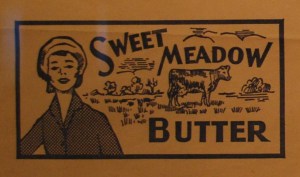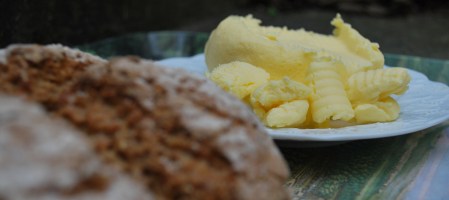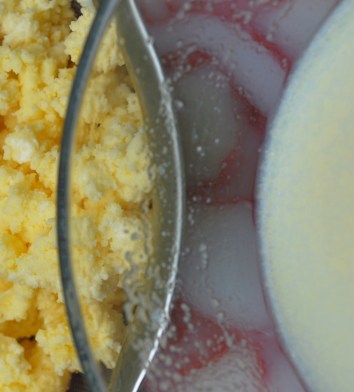This looks as if it’s going to be something of a domestic science lesson; you start with just double cream, flour and baking powder and end up with – well – a tea. But how else do you invite a goddess to tea than by making your own bread and butter; this simple ritual will surely summon her benign presence.
The first seeds of my butter-making ambition were sown a couple of years ago in Cork, the Irish ‘sister’ city of Swansea. Although not officially twinned, Cork and Swansea had been long linked by the means of a sea ferry. The route was the longest, and cheapest, across the Irish Sea and was politely known as ‘the people’s ferry’. Joe Dunthorne’s schoolboy character (Submarine, 2008) taps into its old reputation; ‘the Cork ferry may look like civilisation but it probably contains at least one person vomiting’. The last boat to plough the route was the MV Julia that finally sailed away a couple of years ago. Whatever the truth of on-board life she shed no little glamour in her wake; floating across the night-time bay garlanded with a festive rope of multi-coloured lights that glowed from bow to stern.
When we eventually spent a weekend at Cork and we were glad that we at last had made it
there. There are many gems to be uncovered, including a fine art gallery. The English Market (www.englishmarket.ie) is full of excellent Irish produce (cow’s and goat’s cheeses, fresh fish, meat etc,) and we plan to camp outside with a two ring stove on our next visit.
When in Cork it’s worth climbing up to the historic district of Shandon to visit the remarkable small museum dedicated to butter, of which Cork was a major international supplier in the 19th century (http://corkbutter.museum/). The museum leads you along a fascinating and revealing thread of Irish history from bog butter, The Cattle Raid of Cooley, to EU membership and the subsequent transformation of the country’s economics, especially in the countryside. What particularly struck me was the historic role of women in the production of butter. Behind the heavy ‘masculine’ facade of the neighbouring old Butter Exchange lay the work of the individual women who ran the diaries on the many farms in the surrounding countryside. For them, the long day could start with a three o’clock milking of the cows, the subsequent tasks of skimming the milk and churning the resulting cream could last until the afternoon milking session, the product of which had to be similarly processed well into the evening. This work nevertheless could provide women (especially in the 20th century) with a welcome independent income.
- The imposing facade of the old Butter Exchange, Shandon, with the ‘Four Liars’ clock tower of St. Anne’s on the right. Photo: Mr Edible.
- The Four Liars pub is named after the unsynchronised clock faces of St. Anne’s near by. Photo: Mr Edible.
Let me conjure up a timeless Butter Goddess, for it is put forward that women have been associated with the dairy process since ancient times (as it still is in places). Similar to alcoholic fermentation – which seems to have typically had a male association – the transformation of churned cream to solid butter, and buttermilk, was a mystery clearly involving magic. Where you have magic you have an informed elite with ritual, taboos and, presumably, a continuous oral tradition. Let me add one more element to this. This mooted ‘caste’ of the Butter Goddess may have had an extra allure. The beauty of the dairymaid’s complexion was renowned as they somehow  avoided the disfiguring marks that were widespread from the ancient, and often fatal, disease of smallpox. (It is thought that this could have been due to their exposure to the cowpox virus through the pustules on infected cow’s teats. We do know that this theory led in the 18th century to the deliberate inoculation of individuals as opposed to an accidental one. Smallpox is now considered effectively eradicated by the global extension of this technique).
avoided the disfiguring marks that were widespread from the ancient, and often fatal, disease of smallpox. (It is thought that this could have been due to their exposure to the cowpox virus through the pustules on infected cow’s teats. We do know that this theory led in the 18th century to the deliberate inoculation of individuals as opposed to an accidental one. Smallpox is now considered effectively eradicated by the global extension of this technique).
Not quite on a par with Robert Graves’s White Goddess, but let me dedicated my recipe/ritual to this beautiful, bountiful Butter Goddess.
Double Cream = Butter + Buttermilk
Buttermilk + Flour + Baking Powder = Soda Bread
Butter – by a lazy celebrant.
- One of the ‘mysteries’ of butter-making is the introduction of bacteria culture in the raw cream to ripen it. This occurred naturally in the old-fashioned dairy as successive layers of cream were gradually skimmed and collected over time (white coat laboratory technicians add helpful bacteria strains as part of today’s commercial butter-making process).
- However the Butter Goddess looks kindly on all rituals performed in her name; even ones like mine which made use of a food processor and uncultured cream – that makes a mild-tasting so-called ‘sweet cream’ butter. Being essentially a lazy cook the option of letting the food-processor’s paddle attachment do the hard work was an attractive one. Even so it took about 6 to 7 minutes to get 568ml (1 pint) to the thickened cream stage, then the motor began to labour slightly and, in a truly striking transformation, yellow solids appeared in the cloudy thin liquid – hey presto. A couple of minutes more in the processor stiffened the solids.
- Although most of the buttermilk is easily strained to reserve for the soda bread, the butter solid contains pockets of fluid which have to be removed. Over a strainer I kneaded the mass under the cold tap with the fingers of one hand. The rules of the ritual say ‘until the water runs clear’, the Butter Goddess will tell you when it ready when it tastes more of butter than cream.
- I strained the butter in some twisted muslin and bashed it into shape to remove the final air pockets.
Soda Bread – to bait a deity.
Now the Butter Goddess is invoked, you have to tempt her to stay for tea. Soda bread a surprisingly easy way to bait a deity. For a roughly 15cm (6 inch) loaf you will need to gather together in one place:
250g wholemeal flour.
10g salt.
4 generous teaspoons of baking powder.
300ml buttermilk (being an uncultured buttermilk I made it up with some runny yoghurt for flavour).
1 dessert spoon golden syrup or molasses (I have used tasty Basra date syrup).
- Preheat the oven to Gas Mark 7.
- Mix the flour, salt and baking powder, and gradually combine the buttermilk and golden syrup to make a dough.
- Some recipes say to ‘knead briefly’, I find a gentle palpitation a more effective way to get the dough into a continuous mass – think of a rather solid two-handed stress ball.
- Pat into a round loaf about 5cms (2inches) high, place on a baking tray and incise quite a deep cross into it to aid baking.

- In the past, in the absence of ovens, soda bread was cooked under an inverted pot on a hot griddle. Even with a modern oven it’s a good technique to emulate with a cake tin – failing the use of a cauldron – letting the soda bread rise before a hard crust inhibits its ‘elevation’.

- I took my loaf out of the oven after 25 minute to test it. Tapping the bottom of the bread it sounded as it should, as hollow as an incantatory drum.
How do you know when you have a minor deity to tea? She may be partly embodied in someone you already know. A goddess generally likes jam on her buttered baked products. She likes good company and loves an opportunity to laugh open-mouthed and freely, and she likes others to do the same. She has experienced more than you have; or possibly, more than you think she has for it has not marred her golden glow – why so? – a deity has her secrets and we are not meant to understand everything, you’re role is to put on the kettle on and relish the moment.







